| Pages:
1
2
3 |
Lion850
National Hazard
   
Posts: 517
Registered: 7-10-2019
Location: Australia
Member Is Offline
Mood: Great
|
|
Hi Bedlasky I don't think it is a double salt as I would expect the weight yield to be more than the 12g I got then. Will have to read up more.
|
|
|
Lion850
National Hazard
   
Posts: 517
Registered: 7-10-2019
Location: Australia
Member Is Offline
Mood: Great
|
|
Cobalt gluconate.
- 10g calcium gluconate was dissolved in 100g water. Once near boiling the salt completely dissolved giving a clear solution.
- 6.6g cobalt sulphate heptahydrate was dissolved in 30g water, this gave a dark red solution.
- The hot cobalt sulphate solution was added to the hot calcium gluconate solution, and stirred for 40 minutes while keeping it very hot.
- Stirring was stopped and a heavy white ppt quickly settled, presumably calcium sulphate. The solution was then filtered and a wine-red remainder
obtained.
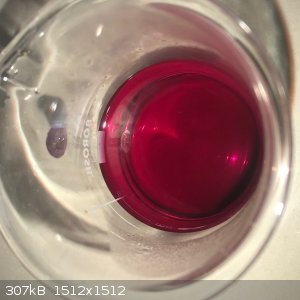
- The beaker with the remainder was placed in a bigger beaker of boiling water. After some hours all that was left was a sticky maroon coloured layer.
** The last time I tried this experiment, a month or so ago, I obtained the same sticky stuff. I then put it on a sand bath at around 200C but it
decomposed into a mess. So I know to try something different.
- Add 150ml methanol to the beaker and boil, topping up with methanol from time to time. This worked recently when I made copper gluconate, but it had
little effect on the cobalt: it remained a sticky blob.
- I then added xylene to get a higher boiling temperature. After boiling for 30 minutes or so it became a swollen mass!. Photo below.
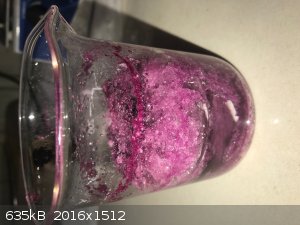
- This mass was no longer sticky. I broke it into smaller pieces so the stirring could work, and stirred it for another 10 minutes or so in
near-boiling xylene. The result was a coarse powder.
- Most of the xylene was decanted off, and the rest filtered off. The remainder was a coarse powder, still wet with xylene as shown below.
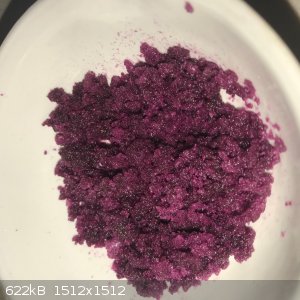
- The product was then dried on a steam bath. The xylene evaporated quickly, after 1 hour the weight was steady.
- Final recovery was spot on 10g of a dry free-flowing powder. Colour is probably maroon, anyway a somewhere between red-pink and purple.
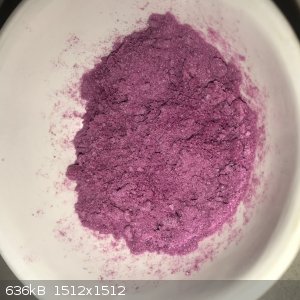
10g represents a yield percentage of 95 which is almost to good to be true. This powder is very fluffy; it occupies a larger volume when one considers
the weight is only 10g.
Cleaning the beaker with concentrated HCl immediately have the lovely blue colour of cobalt chloride.
|
|
|
teodor
International Hazard
    
Posts: 1002
Registered: 28-6-2019
Location: Netherlands
Member Is Offline
|
|
Anhydrous CoCl2
Today I prepared anhydrous CoCl2 by reaction of cobalt acetate 4 hydrate with acetyl chloride in benzene. The procedure is from Brauer, p. 1515.
Co(AcO)2 * 4H2O + 6 AcCl = CoCl2 + 2 Ac2O + 4AcOH + 4HCl
I didn't notice the evolution of HCl, probably it was fully absorbed by the liquid.
The colour change sequence during this reaction is very beautiful, unfortunately I've made a photo only of the start and finish state.
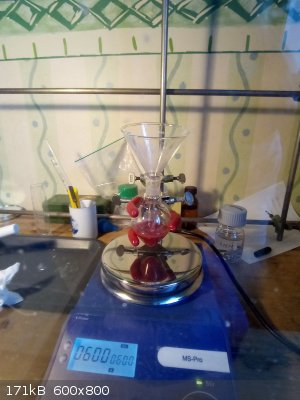 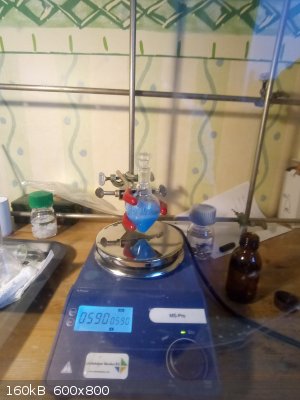
Some notes about preparation of the cobalt acetate 4 hydrate powder. I made it by a reaction of cobalt carbonate and acetic acid, but crystallisation
without seed crystals is a challenge. I've got the seed crystals by evaporating water solution with acetic acid to the syrupy state and adding ethanol
to this.
I did 2 washing of Co(AcO)2 * 4H2O - first with water, and after that the mass became very dense and second with ethanol which converts crystals to a
very fine and diffuse uniform powder.
[Edited on 11-7-2021 by teodor]
|
|
|
teodor
International Hazard
    
Posts: 1002
Registered: 28-6-2019
Location: Netherlands
Member Is Offline
|
|
It's amazing how fast wet anhydrous CoCl2 turns pink on contact with the air. When I opened the flask the compound which was adhered to the stop
changed it colour in few seconds. The only way to keep it anhydrous on contact with the air is to keep some quantity of AcCl in the solution.
I tried to pipette out the solution through cotton wool but its not easy. I think to order an immersion filter.
Also I did interesting experiment adding ether into the flask. The ether dissolves CoCl2 forming very nice blue anhydrous solution.
[Edited on 14-7-2021 by teodor]
|
|
|
Bedlasky
International Hazard
    
Posts: 1251
Registered: 15-4-2019
Location: Period 5, group 6
Member Is Offline
Mood: Volatile
|
|
Et2O will form etherate with CoCl2 (CoCl2.xEt2O).
Btw. anhydrous CoCl2 can be made just by thermal decomposition of hexahydrate. You don't need Ac2O to make it.
[Edited on 14-7-2021 by Bedlasky]
|
|
|
teodor
International Hazard
    
Posts: 1002
Registered: 28-6-2019
Location: Netherlands
Member Is Offline
|
|
Thank you for the reply, Bedlasky.
To check whether it forms stable etherate I can try to boil-off the ether under vacuum but now it is not possible because of AcOH, Ac2O and AcCl. I
have no idea yet how chemically remove them from the ethereal solution.
Yes, I know the method of heating of course, but
1) its interesting to compare the results, because according to Brauer:
"Heating of CoCl2 • 6H2O in a stream of dry HCl at 160-170°C. Simple heating at 140°C yields a somewhat basic salt."
I have no idea how much it is "basic", so it is interesting to compare.
2) AcCl method could be, according to the literature, applied to NiCl2, CuCl2 and it is interesting for me to check and understand why it works for
some particular metals and don't work for some other metals.
By the way, have you idea how to prepare anhydrous acetates of the same metals?
[Edited on 15-7-2021 by teodor]
|
|
|
Bedlasky
International Hazard
    
Posts: 1251
Registered: 15-4-2019
Location: Period 5, group 6
Member Is Offline
Mood: Volatile
|
|
Dehydrataion with Ac2O is great idea for making some anhydrous salts. I just think that it is better to use it for dehydrating salts which decompose
during heating. Ac2O is expensive and hard to obtain chemical. CoCl2 and CuCl2 can be easily dehydrated just by heating. Try dehydration of NiCl2 with
Ac2O, I think that I read that NiCl2 decompose to basic salt by heating. Anhydrous NiCl2 should be yellow. With anhydrous salt you can make
tetrachloronickelates, which are also yellow.
https://en.wikipedia.org/wiki/Tetrachloronickelate
|
|
|
teodor
International Hazard
    
Posts: 1002
Registered: 28-6-2019
Location: Netherlands
Member Is Offline
|
|
Thanks for idea of tetrachloronickelate. I've added it to my TODO list, its very interesting.
AcCl is acetyl chloride. It reacts with a metal acetate forming Ac2O as a byproduct. During this reaction the salt changes anion from acetate to
chloride, so it is not the same as dehydration with Ac2O. You can buy AcCl from S3 chemicals for example, it is a bit expensive, yes, but you need not
too much of it on this scale (also some metal salts are much more expensive).
Ac2O could also be used for dehydration, for example, of SnCl2.
Have you idea which interesting ligands could be added to anhydrous CoCl2, I mean those which are unable to replace OH/water when we try to apply them
to hydrated form?
[Edited on 16-7-2021 by teodor]
|
|
|
Bedlasky
International Hazard
    
Posts: 1251
Registered: 15-4-2019
Location: Period 5, group 6
Member Is Offline
Mood: Volatile
|
|
Oh, sorry, I don't know why I read acetic anhydride instead of acetyl chloride  . .
|
|
|
| Pages:
1
2
3 |